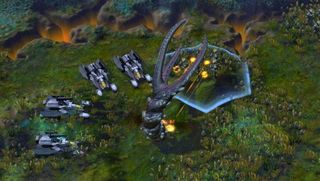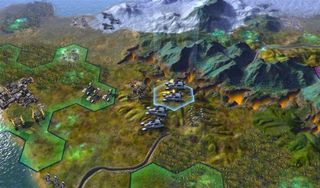Civilization: Beyond Earth hands-on: defining the next phase of human evolution, one turn at a time

I train another squad of soldiers and send them south, then send some colonists to hide behind my embattled northern force. I move my damaged squad one hex back to take them out of a damaging miasma, and line up my scouts to their right. The aliens charge, and fall to the focused fire of my adjacent squads. Next turn, my soldiers smash their hive. I have a feeling I might end up playing Purity in the final game.
While workers lay down a couple of farms and a mine, I send my colonists westward, using the damaged soldiers as a guard. I establish a second colony between some forest tiles, and notice that it doesn't immediately become a full city. In Beyond Earth, you're maintaining a tenuous hold on a world you've yet to master. Every new city starts as a fragile outpost that the planet can snatch away at any moment. You have to establish supply routes from other cities, and feed outposts the materials they need, for them to become towns.
I don't have time to think about that now. My southern soldiers have found strange new things: a mysterious alien ruin, and some floating purple rocks. The latter are one of the new alien resources you can mine, useful for building hovervehicles in the late game. The former hides a trio of alien 'Manticores'. These strange creatures hurl balls of acid with a complicated flick of their tails. Firaxis's artists have clearly had a lot of fun creating elaborate new animations for these exotic units.

They've also created a lot of new terrain. In the final release there will be multiple types of planet to explore. There's a desert biome that'll procedurally generate homages to Dune's Arrakis. The Vulcan biome is overgrown with blue alien fungus, and the large seas of the aqua biome host many undersea alien monsters. Creatures are similar across each biome, but each specialised layout will support some species better than others. For example, in another nod to Dune, you can expect desert planets to be full of huge city-killing Siege Worms. “We cleared the decks and rebuilt the very idea of map generation,” says Miller. “We have these biomes with whole-world palettes with unique plantlife and unique colour schemes and unique layouts and so on, so when you go to one it feels like a different world each time. It's like you went to a whole different part of the galaxy.”
My soldiers condemn the Manticores to a splattery death, and my time with this section of the game comes to an end. Another save is loaded, and I'm dropped into an open stretch of land with three units of soldiers. Suddenly, the hex in front of my soldiers cracks open and a huge worm explodes out of the ground. Its three jaws unravel and it looms over my men, gaping horribly. That'll be the Siege Worm, then.
This is why I'm so excited about Beyond Earth. Unconstrained by history, Firaxis are free to add huge, mad elements to Civilization, making the old familiar format feel fresh. Once the Siege Worm dies, its skull can be recovered and studied, which can trigger a quest. If you complete the set objectives in a quest, you uncover more of the planet's story. Alpha Centauri told its story through text interludes as your campaign progressed. That's now been broken up and folded into the world in a way that makes more room for the player. “We decided very early that we would imply more than we say,” Miller tells me. “I think that's really important, because the gaps the player's going to fill in with their imagination... that's a story way more interesting than the one we could write ourselves.”
Scientists love Siege Worm skulls, but the monsters may be more useful to you alive than dead. Espionage has been expanded to enable serious high-level action: a Harmony spy can activate a thumper in an enemy city, drawing nearby Siege Worms to attack it. If you'd rather not mess with nature, you can sneak-in a suitcase nuke instead.
The biggest gaming news, reviews and hardware deals
Keep up to date with the most important stories and the best deals, as picked by the PC Gamer team.

You can use spies to counter spies, but Beyond Earth also has an orbital layer of strategy. You can launch temporary satellites, which project a zone of influence onto a patch of the planet's surface. Some satellites are good at spotting spies, others can be used for terraforming, and some carry big guns that let you nuke your enemies from the stratosphere. Satellite influence zones can't overlap, so you can use the orbital layer to aggressively muscle-in on enemy territory you might be unable to reach on foot.
Satellites and Siege Worm thumpers are tiny elements in Beyond Earth's huge web of technology. You start at the centre, and research in any direction you choose. The game's other lead designer, David McDonough, explains that the farthest arms of the web represent some of sci-fi's biggest ideas. “Off to the left there's alteration to the human form: cybernetics, surrogacy, putting your brain in a can.” That road leads to trans-humanism. Elsewhere lie communication and data sciences. “Imagine a world run by the unholy alliance of Twitter and Wikipedia.” If that fills you with horror, you can always dig into xenosciences, or genetic manipulation, or terraforming, which has the power to “shake the very ground under your enemies.”
McDonough describes the tech tree as 'the engine' of the game, but your choice of destination even better demonstrates the quality of imagination behind Beyond Earth. Victory conditions are numerous. Any player can build a beacon to make first contact with a sentient alien race, and Harmony players can commune with the planet's collective consciousness to achieve a transcendent state of sentience. Both worthy options, but Purity and Supremacy players can actually build a portal back to Earth. Purity players then draw Earth troops out of the portal to claim the new planet in the name of the old world. Supremacy players send their monstrous bionic commandos into the portal as an invading force, to impose bionic ascendency on their fellow humans. You become the Borg. As objectives go, that's a fantastic reason to keep clicking 'next turn'. I look forward to being assimilated.
Part of the UK team, Tom was with PC Gamer at the very beginning of the website's launch—first as a news writer, and then as online editor until his departure in 2020. His specialties are strategy games, action RPGs, hack ‘n slash games, digital card games… basically anything that he can fit on a hard drive. His final boss form is Deckard Cain.

If you love big trucks, establishing trade routes, and the phrase 'post-apocalyptic survival business simulator' then I've got just the strategy RPG for you

Blizzard veteran David Kim's strategy comeback with Battle Aces is 'very personal:' 'I just can't accept... the end-all peak of RTS is StarCraft 2 and nothing can ever be better'
Most Popular


